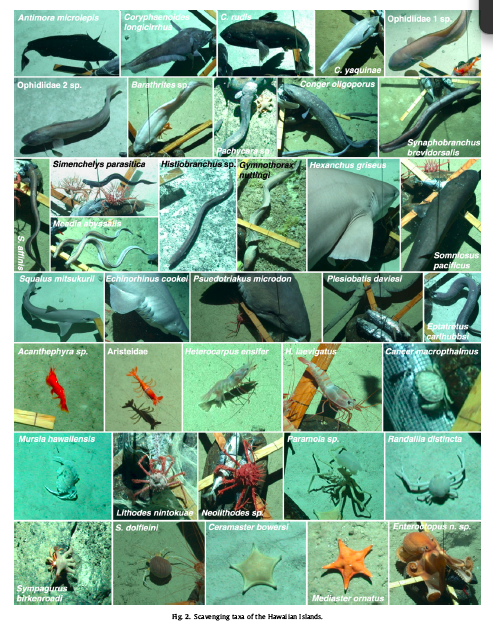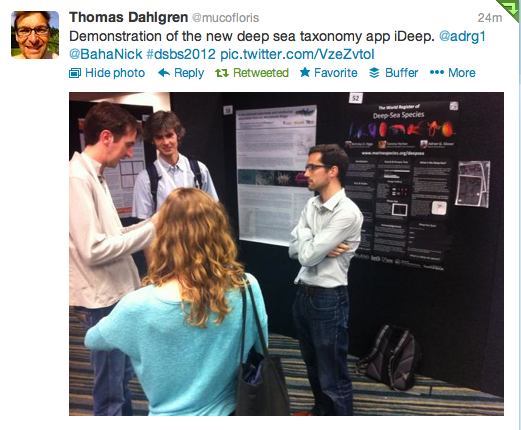The post Deep-sea researchers convene at #dsbs2012 this week in New Zealand first appeared on Deep Sea News.
]]>Word on the street is that there are ~200 deep-sea biologists attending, and the one and only James Cameron will be delivering a plenary talk about his badass Deepsea Challenge submersible on Tuesday morning. Unfortunately I couldn’t attend this year, so I’ll be following along online whilst drowning my sorrows in Grey Goose martinis (and maybe inventing a twitter-based drinking game?).
Day 1 has already seen some über cool stuff, such as the new iDeep app being released for deep-sea taxonomy. What other exciting news will unfold??
The post Deep-sea researchers convene at #dsbs2012 this week in New Zealand first appeared on Deep Sea News.
]]>The post Coral: Symbol, Substance, and Significance first appeared on Deep Sea News.
]]>Symbol, Substance, and Significance will be a comprehensive examination of this astonishing organism, exploring its place in both the natural world and in the realm of culture where it has been a traditional material for art objects and jewelry. Beginning with the role of coral within the reef and the criticality of coral reefs to ocean ecology – and thus to human existence – we will turn to forces threatening reef survival, and to efforts being made by scientists, governments, and nongovernmental organizations to protect and restore them. We will address laws and treaties formulated to govern trade in coral, a substance that has been termed “too precious to wear.” And we will examine coral in history, both its evolving associations over time and its traditional place in the wunderkammer. Last, we will explore its changing role and use in jewelry, art, and fashion, with specific discussion of the move both to the mimetic use coral alternatives and the symbolic use of coral as an inspiration. Initiatives in Art and Culture has a long-standing commitment to explorations both of cultural patrimony and of art and ornament. In Coral, we again celebrate the object by placing it in the broadest possible context, discussing strategies and approaches to ensuring its sustainability.
Among those who have agreed to speak are: Michael Kowalski, Chairman and CEO of Tiffany & Co.; Richard E. Dodge, professor and dean, Nova Southeastern University (NSU) Oceanographic Institute and Executive Director of the Center’s Coral Reef Institute (NCRI); Michele Oka Doner, artist whose breadth of artistic production encompasses public art, sculpture, furniture, jewelry, and functional objects, a significant number of which draw inspiration from coral and the sea; Godfrey Reggio, producer and director, who is prominent in the film world for his Qatsi trilogy (Koyaanisqatsi, Powaqqatsi, and Naqqyqatsi, music by Philip Glass) which conveys a humanist philosophy about the earth, chronicling the destructive impact of the modern world on the environment, and for Anima Mundi, (music also by Philip Glass); David Wolfe, creative director and chief forecaster of Doneger and Co.; Sarah Graham, jeweler whose point of departure for her coral inspired work are the plates of the zoologist and contemporary of Darwin, Ernst Haeckel, published in Art Forms in Nature; Steve D’Esposito, president RESOLVE and formerly president, Earthworks Action; Dawn Martin, president of SeaWeb; and Géza von Habsburg, an art historian who has served as chairman of two auction houses and whose numerous publications include Princely Treasures (1997) and several definitive volumes on Fabergé. The conference is organized by Lisa Koenigsberg, president and founder, Initiatives in Art and Culture.
The post Coral: Symbol, Substance, and Significance first appeared on Deep Sea News.
]]>The post To Blog or Not To Blog first appeared on Deep Sea News.
]]>Nature has made the case that blogging by researchers is good. Critical discussion of worthy results should not in principle be restricted to walls of a conference hall or even the pages of a journal. Any meeting to which anyone can register is fair game for all available communications technologies — and any rules that cannot be policed will be ignored anyway.
Of course, I have my own opinions on this but what what do our readers, often scientists and bloggers, think?
The post To Blog or Not To Blog first appeared on Deep Sea News.
]]>The post Big Gulpers In The Deep first appeared on Deep Sea News.
]]>In March last year I attended the 2008 Ocean Sciences Meeting put on by the American Society of Limnology and Oceanography in Orlando, FL. It was a good conference, with two special sessions devoted to deep sea biology! I presented a poster on new species of anemones from near hydrothermal vents in the Lau Basin. That paper is currently in press. I also took a few pictures of some of the posters. Here is one that caught my eye in my spring macbook cleaning that I thought I would share. It is a gulper eel black swallower, Chiasmodon niger, with a bit more snake mackerel than it can chew! The poster was by John Yeh and Jeffrey Drazen and titled: “DEPTH ZONATION OF DEEP-SEA MEGAFAUNAL SCAVENGERS OF THE HAWAIIIAN ISLANDS”.
We are big fans of the Drazen Lab’s work here. They were kind enough to let us release this awesome deep sea shark video last year. I noticed recently that Yeh and Drazen’s work on deep sea scavengers was published just this month in Deep Sea Research. Several baited camera traps were placed around the Hawaiian islands from depths of 250 to 4,753 meters.
They were interested in capturing on film who and how many scavenger species showed up at their traps. For the scavengers in question, finding the traps was not a problem. A synaphrobranchid eel was spotted only 10 minutes into the experiment! Yeh and Drazen also documented the first occurrence of a zoarcid fish in Hawaiian waters. Zoarcids are often found near vents, though they occur elsewhere in the deep-sea.
The most striking result was the discovery of a break in scavenger community composition at around 500-1,000 meters. This also correlated with a drop in the local oxygen minimum zone in the ocean. There appears to be a physiological cause, as a result of dissolved oxygen concentration, for the change in the scavenger community composition. In general, crustaceans were more abundant at shallower depths and teleost fish dominated the deeper study sites. This may have to do with an organisms ability to use oxygen efficiently under pressure.
Another find, contrary to some research (including our very own Dr. M’s), included non-unanimous support for the “bigger is deeper” hypothesis. In synaphrobranchid eels that spanned both shallow and deep sites, a significant negative relationship between length and depth was found. These fish were smaller at deeper depths. This was not previously reported for scavenging fish before. The authors thought the eel might instead be a specialist of some sort, not a scavenger. Though examination of stomach contents and jaw morphology suggest it is indeed a scavenger, Yeh and Drazen acknowledge sampling biases and suggest a targeted sampling program for this species to test whether this result is real or a sampling artifact.
This study is interesting in that it detected a major faunal break at 1,000 meters correlated with a sharp decrease in oxygen. But it also notes many unusual taxonomic and natural history observations. Though anecdotal, they add to the literature of observations on some of the most rarely seen or studied animals on this planet. I’ll leave this post with this great taxonomic guide they published in their article.

J YEH, J DRAZEN (2009). Depth zonation and bathymetric trends of deep-sea megafaunal scavengers of the Hawaiian Islands Deep Sea Research Part I: Oceanographic Research Papers, 56 (2), 251-266 DOI: 10.1016/j.dsr.2008.08.005
The post Big Gulpers In The Deep first appeared on Deep Sea News.
]]>
